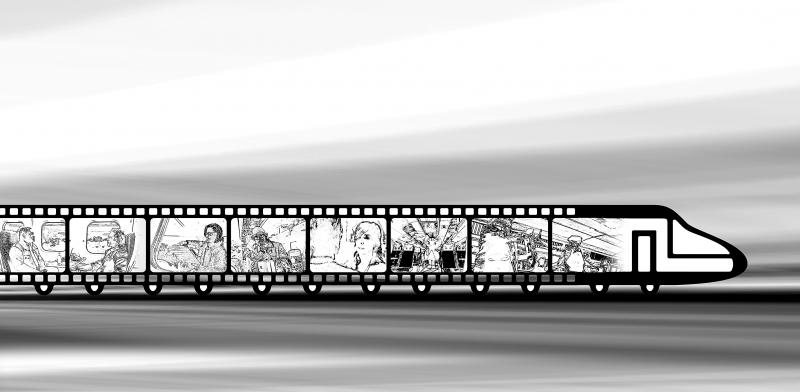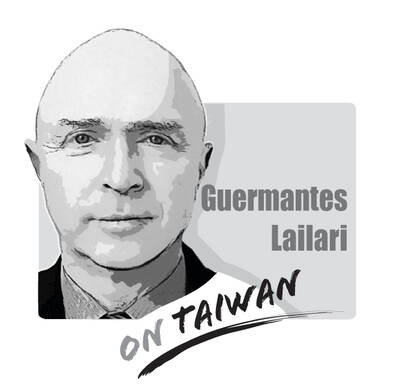In the world of the movie Bullet Train, opening in US theaters this weekend, Brad Pitt is an assassin in a hyper-stylized, neon-tinged Japan. Sandra Bullock and Puerto Rican pop sensation Bad Bunny also appear.
Forget them. The real star should be the train. A staple set for any movie that takes place in Japan, from Lost In Translation to Inception, it is about time the Shinkansen itself got top billing. Based on a novel by Japanese mystery writer Kotaro Isaka, Bullet Train shows the enduring obsession with Japan’s ultra-efficient and super-fast trains, nearly 60 years since their introduction.
Famously, there has never been a fatal accident — not even when a Shinkansen derailed earlier this year after a magnitude 7.4 earthquake.

Illustration: June Hsu
However, these are tricky times for what is perhaps the world’s most famous train. The COVID-19 pandemic has altered lifestyles in Japan in a way that might be permanent. Zoom calls are increasingly taking the place of the business day-trips that are the backbone of bullet-train revenues, and foreign tourists remain largely absent.
East Japan Railway Co said that revenue from its bullet trains — which includes the Tohoku Shinkansen route between Tokyo and Morioka used in Isaka’s original novel — is less than 60 percent of pre-pandemic times, and expects that the figure could still be 10 percent below 2019 levels at the end of its fiscal year in March next year.
On the more famous Tokyo-Osaka route, operated by JR Central and featured in the movie version of Bullet Train, ridership remains at just 70 percent of pre-pandemic levels.
This problem comes just five years before JR Central is supposed to open a brand new, 500kph line using magnetic levitation, or maglev, technology to connect Tokyo and the industrial heartland of Nagoya in just 40 minutes, at a cost of more than US$50 billion.
It is far from the only issue the trains are facing.
The maglev project itself seems highly unlikely to make its 2027 opening date, with work halted in Shizuoka Prefecture over an environmental dispute. Cynics suspect that the opposition might have more to do with the fact that, while the train is slated to pass through the prefecture, it was not deemed important enough to merit a lucrative stop.
Set to be the fastest in the world when it begins service, the train is likely to generate higher energy costs. At a time when Japan is facing the prospect of blackouts due to an energy supply squeeze, the maglev uses several times the power of a regular bullet train for its superconducting magnetic lines.
In Japan’s southernmost island, JR Kyushu next month plans to open what is being referred to as the country’s shortest bullet train. The new route joins Nagasaki with Takeo Onsen in Saga Prefecture — but the track, just 67km long, is not linked to the rest of the Shinkansen network. A dispute between national and local authorities means work to link to lines serving elsewhere in Kyushu has not even begun.
Further north, the Hokkaido Shinkansen is still losing money — US$111 million last fiscal year alone, with an average of just 1,700 people riding the train each day. An extension to Sapporo planned to open in 2030 — the year the city might host a Winter Olympics — as well as the ski paradise of Niseko cannot come fast enough.
However, the issue attracting most discussion among Japan’s train lovers involves decidedly slower lines. The sustainability of local routes that are the lifelines criss-crossing much of the rural countryside has become a topic of debate. Ridership on some lines in JR West’s area has fallen to 10 percent of the level when the firm was privatized in the late 1980s, with more adults owning cars and fewer young people to take their place on the train. That has led management to talk for the first time about potentially shutting some of these lines, something opposed by the elderly.
The impact of changing times can be felt on Tokyo’s trains, too. Rail operators, including JR East, have brought forward the last train by 30 minutes, with fewer people staying out late due to the growing acceptance of remote work and a lingering reluctance to go to out drinking where COVID-19 might be spreading.
These changes highlight problems that are increasing as Japan’s population ages and shrinks; the pandemic has merely put these long-standing issues in focus. The bullet trains have long been profit-drivers for the JR companies, which were privatized in such a way that gave each of them a piece of the pie in return for maintaining money-losing rural routes.
However, this is also the beauty of Japan’s trains. While being private, dividend-paying enterprises, they also operate partly as a public service, whether it is maintaining old train lines with dwindling ridership or moving ahead with ambitious projects such as the maglev.
With the UK hemming and hawing over its High Speed 2 rail link for northern England, and the US permanently vacillating over the merits of high-speed rail, it is good to have a first-world nation that still appreciates the role of infrastructure ahead of the relentless pursuit of profit.
Skepticism over the maglev is understandable. Still, it is worth keeping in mind that the original Tokyo-Osaka Shinkansen itself was derided as being as expensive and functionally useless as the Pyramids, the Great Wall of China and the ill-fated World War II battleship Yamato.
Now, the bullet train is the star of a movie, highlighting the international envy a forward-thinking infrastructure project can bring.
Who knows? Perhaps Brad Pitt can even star in a maglev-set sequel.
Gearoid Reidy is a Bloomberg News senior editor covering Japan. He previously led the breaking news team in North Asia and was the Tokyo deputy bureau chief. This column does not necessarily reflect the opinion of the editorial board or Bloomberg LP and its owners.
Congratulations to China’s working class — they have officially entered the “Livestock Feed 2.0” era. While others are still researching how to achieve healthy and balanced diets, China has already evolved to the point where it does not matter whether you are actually eating food, as long as you can swallow it. There is no need for cooking, chewing or making decisions — just tear open a package, add some hot water and in a short three minutes you have something that can keep you alive for at least another six hours. This is not science fiction — it is reality.

A foreign colleague of mine asked me recently, “What is a safe distance from potential People’s Liberation Army (PLA) Rocket Force’s (PLARF) Taiwan targets?” This article will answer this question and help people living in Taiwan have a deeper understanding of the threat. Why is it important to understand PLA/PLARF targeting strategy? According to RAND analysis, the PLA’s “systems destruction warfare” focuses on crippling an adversary’s operational system by targeting its networks, especially leadership, command and control (C2) nodes, sensors, and information hubs. Admiral Samuel Paparo, commander of US Indo-Pacific Command, noted in his 15 May 2025 Sedona Forum keynote speech that, as
In a world increasingly defined by unpredictability, two actors stand out as islands of stability: Europe and Taiwan. One, a sprawling union of democracies, but under immense pressure, grappling with a geopolitical reality it was not originally designed for. The other, a vibrant, resilient democracy thriving as a technological global leader, but living under a growing existential threat. In response to rising uncertainties, they are both seeking resilience and learning to better position themselves. It is now time they recognize each other not just as partners of convenience, but as strategic and indispensable lifelines. The US, long seen as the anchor
Chinese Nationalist Party (KMT) Chairman Eric Chu (朱立倫) last week announced that the KMT was launching “Operation Patriot” in response to an unprecedented massive campaign to recall 31 KMT legislators. However, his action has also raised questions and doubts: Are these so-called “patriots” pledging allegiance to the country or to the party? While all KMT-proposed campaigns to recall Democratic Progressive Party (DPP) lawmakers have failed, and a growing number of local KMT chapter personnel have been indicted for allegedly forging petition signatures, media reports said that at least 26 recall motions against KMT legislators have passed the second signature threshold